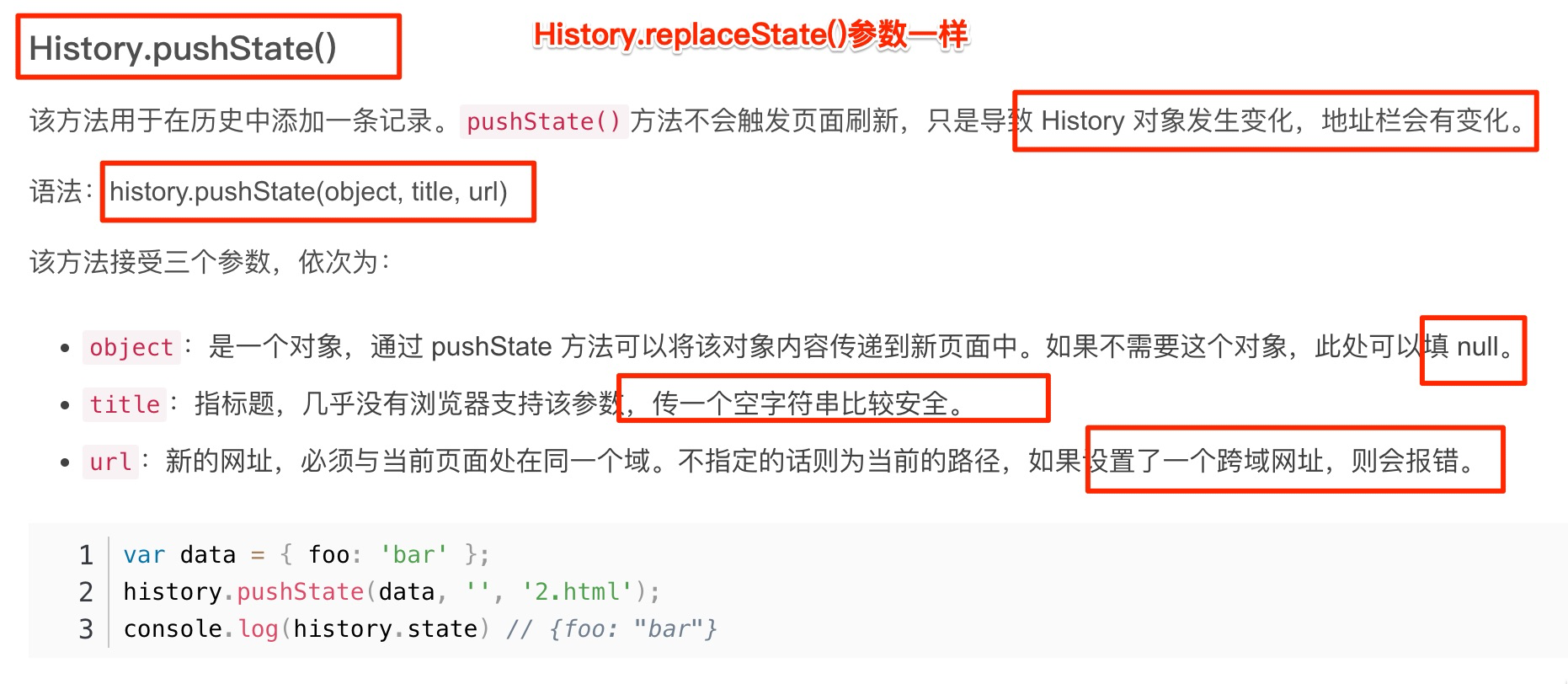实现一个简易版本的前端路由
#前端框架
目录
1. 总结
- 哈希路由
- 监听两个事件
- DOMContentLoaded -> onLoad
- 主动触发一次 onHashChange
- hashchange -> onHashChange
- 每次更新直接修改
#app的innerHtml
- 每次更新直接修改
- DOMContentLoaded -> onLoad
- 监听两个事件
- history 路由
- 监听两个事件
- DOMContentLoaded -> onLoad
- 主动触发一次
onPopState
- 主动触发一次
popstate->onPopState- 每次更新直接修改
#app的innerHtml - 拦截
a 标签的默认行为
- 每次更新直接修改
- DOMContentLoaded -> onLoad
- 监听两个事件
2. 哈希路由简易实现
- 关键点
- 监听两个事件
- DOMContentLoaded -> onLoad
- 主动触发一次 onHashChange
- hashchange -> onHashChange
- 每次更新直接修改
#app的innerHtml
- 每次更新直接修改
- DOMContentLoaded -> onLoad
- 监听两个事件
<body>
<ul>
<!-- 定义路由 -->
<li><a href="#/home">home</a></li>
<li><a href="#/about">about</a></li>
</ul>
<!-- 渲染路由对应的 UI -->
<div id="app"></div>
</body>
<script type="text/javascript">
// 页面加载完不会触发 hashchange
// 所以这里需要主动触发一次 hashchange 事件
window.addEventListener("DOMContentLoaded", onLoad);
// 监听路由变化
window.addEventListener("hashchange", onHashChange);
// 路由视图,用于渲染路由对应的 UI
var routerView = null;
function onLoad() {
routerView = document.querySelector("#app");
onHashChange();
}
// 路由变化时,根据路由渲染对应 UI
function onHashChange() {
switch (window.location.hash) {
case "#/home":
routerView.innerHTML = "Home";
return;
case "#/about":
routerView.innerHTML = "About";
return;
default:
return;
}
}
</script>
3. history 路由简易实现
- 关键点
- 监听两个事件
- DOMContentLoaded -> onLoad
- 主动触发一次 onPopState
- popstate -> onPopState
- 每次更新直接修改
#app的innerHtml - 拦截 a 标签的默认行为
- 每次更新直接修改
- DOMContentLoaded -> onLoad
- 监听两个事件
<body>
<ul>
<!-- 定义路由 -->
<li><a href="#/home">home</a></li>
<li><a href="#/about">about</a></li>
</ul>
<!-- 渲染路由对应的 UI -->
<div id="app"></div>
</body>
<script type="text/javascript">
// 页面加载完不会触发 hashchange
// 这里主动触发一次 hashchange 事件
window.addEventListener("DOMContentLoaded", onLoad);
// 监听路由变化
window.addEventListener("popstate", onPopState);
// 路由视图
var routerView = null;
function onLoad() {
routerView = document.querySelector("#app");
onPopState();
// 拦截 <a> 标签点击事件默认行为, 点击时使用 pushState 修改 URL并更新手动 UI,
// 从而实现点击链接更新 URL 和 UI 的效果。
var linkList = document.querySelectorAll("a[href]");
linkList.forEach((el) =>
el.addEventListener("click", function (e) {
e.preventDefault();
history.pushState(null, "", el.getAttribute("href"));
onPopState();
}),
);
}
// 路由变化时,根据路由渲染对应 UI
function onPopState() {
switch (location.pathname) {
case "/home":
routerView.innerHTML = "Home";
return;
case "/about":
routerView.innerHTML = "About";
return;
default:
return;
}
}
</script>
3.1. 附:popstate 事件
- 仅仅调用
pushState()方法或replaceState()方法 ,并不会触发该事件;- 只有用户
点击浏览器倒退按钮和前进按钮, - 或者使用 JavaScript 调用
History.back()、History.forward()、History.go()方法时才会触发。 - 或者点击
a 标签的跳转
- 只有用户
- 另外,该事件只针对同一个文档,如果浏览历史的切换,导致加载不同的文档,该事件也不会触发。
- 页面
第一次加载的时候,浏览器不会触发popstate事件 pushState 与 replaceState调用后 History 对象会变化,地址栏会变化,但不会触发页面刷新事件
4. 一个简单的 Router 类实现
4.1. 入口
<!DOCTYPE html>
<html>
<body>
<nav>
<a href="/" data-link>Home</a>
<a href="/about" data-link>About</a>
<a href="/contact" data-link>Contact</a>
</nav>
<div id="app"></div>
<script src="router.js"></script>
</body>
</html>
4.2. Router 实现
class Router {
constructor(routes) {
this.routes = routes;
this.rootElement = document.getElementById("app");
this.init();
}
init() {
window.addEventListener("popstate", this.handlePopState.bind(this));
this.handleRouteChange();
this.bindLinks();
}
// 为所有带有 data-link 属性的链接添加点击事件监听器
// 阻止默认行为并调用 navigateTo 方法
bindLinks() {
document.addEventListener("click", (e) => {
if (e.target.matches("[data-link]")) {
e.preventDefault();
this.navigateTo(e.target.href);
}
});
}
handlePopState() {
this.handleRouteChange();
}
// 获取当前路径
// 查找匹配的路由
// 如果找到匹配的路由,渲染对应的组件
// 如果没有找到匹配的路由,显示 404 页面
handleRouteChange() {
// 获取当前路径
const path = window.location.pathname;
const route = this.routes.find((route) => route.path === path);
if (route) {
this.rootElement.innerHTML = route.component();
} else {
this.rootElement.innerHTML = "<h1>404 Not Found</h1>";
}
}
// 使用 History API 更新 URL
// 触发路由变化处理
navigateTo(url) {
history.pushState(null, null, url);
this.handleRouteChange();
}
}
// 使用示例
const routes = [
{
path: "/",
component: () => "<h1>Home Page</h1>",
},
{
path: "/about",
component: () => "<h1>About Page</h1>",
},
{
path: "/contact",
component: () => "<h1>Contact Page</h1>",
},
];
const router = new Router(routes);
5. mini-react-router-dom 的简易实现
使用最新的 Hooks 的方式实现
#todo
很多细节需要慢慢实现,比如
- 嵌套路由等
- 路由守卫
- 支持参数查询
- 路由过渡动画
- 路由懒加载
- 更复杂的路径匹配模式
- 路由元信息
- 路由钩子(beforeEach, afterEach)等
